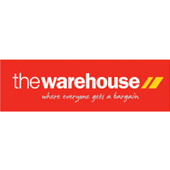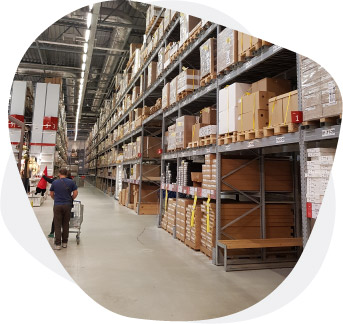The Warehouse Ltd

Business objective
New Zealand retail giant, The Warehouse (TWL) wanted to automate restocking from its New
Zealand suppliers.
Business benefits
Both TWL and its suppliers will:
- Improve supply chain efficiencies
- Reduce errors
- 降低供应链成本
B2BE solutions
The Warehouse use e-ordering and ASN’s to streamline their stock procurement
The Warehouse Ltd. (TWL) is one of New Zealand’s largest retailers, known and loved by Kiwis for its wide range of products in its many departments.
TWL have been providing Kiwis with ‘a bargain’ since 1982. New Zealand owned and operated, TWL have 89 stores throughout New Zealand and over 9,000 employees.
The Warehouse use e-ordering and ASN’s to streamline their stock procurement
New Zealand’s retail giant The Warehouse has, with the help of B2BE, updated its procurement procedures. The first four The Warehouse suppliers (SIMS Distribution, 3M, Energizer and Proctor & Gamble,) are now on-board with full: e-ordering, ASN and e- invoicing covering all three types of The Warehouse Orders.

The challenge
Due to its breadth of products, TWL have over 800 New Zealand based suppliers and 89 stores. This can lead to a lot of paperwork to keep stores stocked with the vast range of TWL products. This paper has a negative impact on stock visibility, lead times and creates errors and costs for both suppliers and TWL.
To make the restocking of stores work as efficiently as possible TWL has 3 types of Orders. These are: direct to store Orders, direct to warehouse Orders and the most complex are the Orders TWL calls ‘pick and pack’. In ‘pick and pack’ Orders, suppliers send TWL one shipment with goods pre-packed by store. TWL consolidates the goods in a consignment with other suppliers’ goods that are going to the same individual TWL stores.
Ray Renner, TWL EDI Project Manager – Business, says ‘If you take our supplier SIMS as an example, sometimes one Order could be 36 pages long and would take them up to an hour to manually input. Then, to ensure quality control, before we would confirm the Order, it had to balance and if there was an error (which could be in the quantity, the price, the volume or the code) then finding the error was a real pain for SIMS and TWL.’ Ray adds ‘Suppliers’ costs becomes retailers’ costs and suppliers’ problems become retailers’ problems, so if we can remove time and errors for suppliers then it benefits The Warehouse.’


There are direct costs to TWL of dealing with all this paper. Ray says ‘the financial information on each invoice has to be entered into our computer system, matched to the order, and variances verified and adjusted there is a lot of expense and potential for error. TWL use OCR to scan and translate Invoices into a PDF but that still requires a lot of manual work and intervention and that can lead to errors as well and all of that means lots more costs for TWL.’
“This Will Drive Large Process Improvements From Which Twl And Our Suppliers Will Reap Significant On-going Savings”
Ray Renner, TWL EDI Project Manager.
Lawrence Diamond of Energizer agrees saying ‘On a typical day we might get 20-30 Orders from TWL but if each Order has 20 – 26 line items (and they can have 70 – 100 items) then this requires significant extra resources (such as re-keying the data) and the chance for errors is enormous. Once you have to correct an error there are further direct costs and this adds delays to the supply chain.’
The nature of the restocking and ordering meant that TWL wanted to know what stock suppliers could and could not supply – so any electronic system also had to allow for partially supplied Orders and yet be simple enough that the suppliers ERP systems could cope with what TWL wanted. Ray says ‘the e-ordering system has to work with all three order types because the system must fit TWL stock purchasing system and not the other way round. However, you have to have an e-ordering system that suppliers can comply with as well, so it can’t be too complicated.’
解决办法
Ray worked with TWL staff and B2BE to rework the process so all Orders and supply chain documents can be sent and received electronically.
First Ray surveyed 120 of TWL’s 800 New Zealand suppliers to find out three key things about them: who was already doing EDI; who could provide an ASN; and who currently went via a Value Added Network provider (VAN). Ray used the survey information to drive who would be in the pilot (which would help refine the system) and who would be in the next stages of on-boarding.
Also by talking to key suppliers, B2BE and internal TWL staff, Ray was able to come up with a system that provided a balance between automating the procurement system, allowing a structured stock conversation to take place electronically and not overburdening suppliers with difficult new processes.
The e-Ordering message flow is: TWL output an Order file. The output file’s content is different depending on what type of Order it is (e.g. ‘pick pack’ or not). TWL send the Order to B2BE in UBL format, B2BE then convert the Order into the message structure and format that is acceptable for the supplier. Once the supplier inspects their stock they send back an Advanced Shipping Notice (ASN) to B2BE who translate it for TWL. B2BE can also check what type of Order it was and that the ASN (or Invoice) has the right information for that type of Order. When sending an Invoice, the supplier again outputs a file that B2BE translates to the TWL format and sends to TWL.
This use of an ASN allows TWL to see what is being sent before it arrives. If an ASN is for a partial Order fulfilment TWL have a manual intervention process and can, if needed, then take remedial action (such as phoning the supplier or talking to other suppliers) so that the stores have the right volume of goods.


What the suppliers said
Energizer fulfils DC Orders and direct to store Orders (not ‘pick pack’) with TWL. Lawrence Diamond of Energizer said, ‘It was one of the simplest EDI projects we have done. Our output files have lots of information in them so we just needed to supress the right data to produce the ASN that The Warehouse wanted. So we just handed our file content to B2BE and they checked against the data TWL wanted, B2BE wrote a conversion map for it and now B2BE convert our files into two messages, an ASN and an Invoice for TWL.’
Lawrence added, ‘We got the project going very quickly. It was probably two weeks work of dedicated testing.’
SIMS Distribution has all 3 types of TWL Orders. Shayne Harris (from AOS Computers & IT – specialists in SIMS payment system Accredo) acted as the consultant to SIMS on this project. Shayne said, ‘The solid pack and direct to store Orders were not that difficult to do but implementing the pick and pack was more challenging because, for SIMS, we needed to make changes to their other internal systems and processes. For example, we put in a new barcode scanning into the SIMS warehouse. But having made those changes it is good to be live on the e-Ordering system for all 3 types of Orders.’
The result
From the suppliers perspective Lawrence at Energizer says, ‘It has made a big difference already in the number of people keying in Orders. Now the first people to see an Order are the people in the Energizer warehouse when they go to pack it!’
Ray says ‘Previously, receipting of orders that were not fully supplied would require additional checking and paperwork to verify. Now, the ASN acts as notification of what TWL should actually get so when an Order arrives it accurately reflects the ASN and tallies with our receiving system. This makes ordering go much smoother for The Warehouse and so as well as the cost saving, it will assist us to save time in the supply chain as well.’
Ray adds, ‘It’s a little early to be specific about quantifying the process improvements and subsequent dollar savings that these changes will bring for TWL and for our suppliers. However, already with the four pilot suppliers now on-board, TWL and our suppliers are already seeing process improvements that will lead to cost savings for us both. TWL hope to have the next 20 – 30 suppliers on-board in the next few months and as the top 40 NZ suppliers account for 50% of NZ generated inventory this will drive large process improvements from which TWL and our suppliers will reap significant on-going savings.’